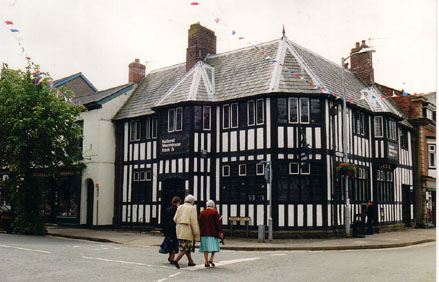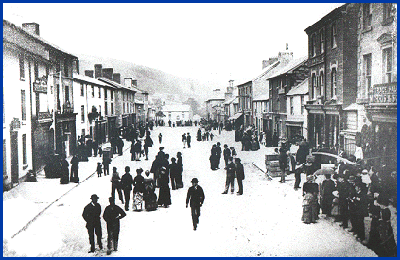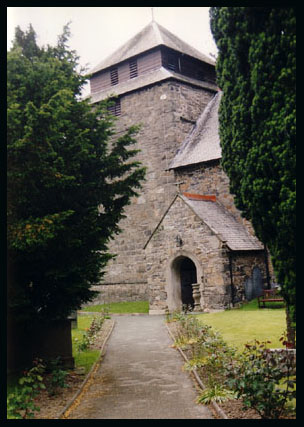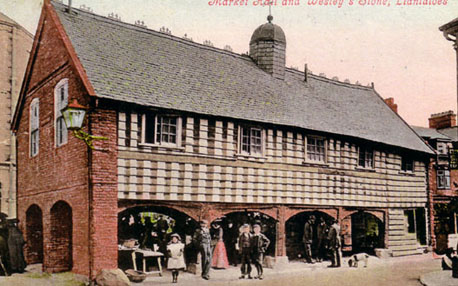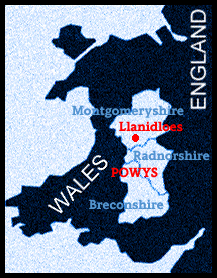|
An entry from Pigot and
Co's Trade Directory (North Wales) of 1835
LLANIDLOES
Llanidloes is a market town, in the parish and hundred of its name,
county of Montgomery; 187 miles NW from London; 60 miles SSW from Chester
and 45 miles SW from Shrewsbury; pleasantly situate in a valley, nearly
surrounded by mountains and at the confluence of the rivers Severn and
Clewwdog. The head of the former noble stream being within the distance
of nine miles on the eastern side of the Plynlimnson mountain. Over
this river are two handsome stone bridges one of which, the largest,
was completed in 1826 at an expense of £3,000. The town consists
of two spacious streets through one of which, the high road from Rhayader
to Machynlleth passes; and through the other that from Aberystwith to
Newtown. The government of the town is vested in a mayor, aldermen,
coroner and various other officers who are elected annually at the borough-leet,
of which Lord Mostyn is the lord, Sir Watkin Williams Wynn is lord of
the manor of Arnstley, which comprises the parish of Llanidloes and
six other parishes. He holds a court-baron (the jurisdiction of which
is co-extensive with the manor) every three weeks, for the recovery
of debts & damages under 16 shillings. Petty sessions are also held
on the first Thursday in every month, by such of the magistrates for
the country as reside within the hundred. Llanidloes was originally
a borough, contributory, with others in the county to the parent borough
of Montgomery but was disfranchised about a century ago. It still, however,
retained and yet retains various corporate privileges been again enfranchised
by the Reform Bill and in conjunction with Montgomery and other places
(named under the head of that borough), is now entitled to retain one
member to parliament. The number of registered voters is about one hundred.
Fifty eyars this was the first town in the county for the manufacture
of flannels. This trade is still carried on to a considerable extent
and the finest and best of this article is made here. Upon the streams
of water are many mills and factories for the carding and spinning of
wool and grinding corn and in the neighbourhood are miners of lead,
worked to advantage.
The places for divine worship here are the parish church, four chapels
for the service of the dissenters and a meeting-house belonging to the
Society of Friends. The church is dedicated to St Idloes; the living
is a vicarage, in the gift of the Bishops of Bangor and incumbency of
the Rev. John Davies. The chapels are very spacious, that of the Calvinist
will seat upwards of one thousand persons and the Wesleyan Methodist
chapel affords accommodation nearly as extensive. In the vicinity of
this town are several handsome residences, the property of opulent individuals;
amongst the most distinguished is 'Dollys', the seat of George Meares
Esquire, situate about a mile from the town on the road leading to Trefeglwys
from which the approach to Llanidloes is highly picturesque. The appearance
of the vale with the Severn beautifully winding and the hills by which
the prospect is boarded, all are in unison to render this spot highly
interesting. The lands about the town and in the vale are fertile and
well cultivated, rich in wood and foliage, while the roads around are
kept in superior order. There is an excellent market on Saturday for
wool, grain and all marketable commodities. The fairs take place on
the second Saturday in February, the first Saturday in April, the 11th
of May , Saturday before the 24th June, the 17th July, the second Saturday
in September, the first Friday in October, the 28th October and the
Saturday before the 16th of December- for wool, horses, cattle, sheep
and swine. The parish of Llanidloes comprises the townships of Kilmarham,
Llanidloes, Llanidloes third division, Manleth, Birthdir, Treflyn and
Cross-Al-Inybln containing collectively at the census taken in 1821
3145 inhabitants and by that for 1831 4189. The population of the town,
according to information furnished by a resident, amounted in October
1834 to 2525 persons.
POST OFFICE, Long Bridge Street; James Morris- Post Master. Letters
from London and other parts East arrive from Newtown by mail car, every
evening at seven and are dispatched every morning at five. Letter from
Aberystwith, Rhayader, South Wales and the West of England arrive by
horse post, every forenoon at eleven and are dispatched every evening
at eight.
|
